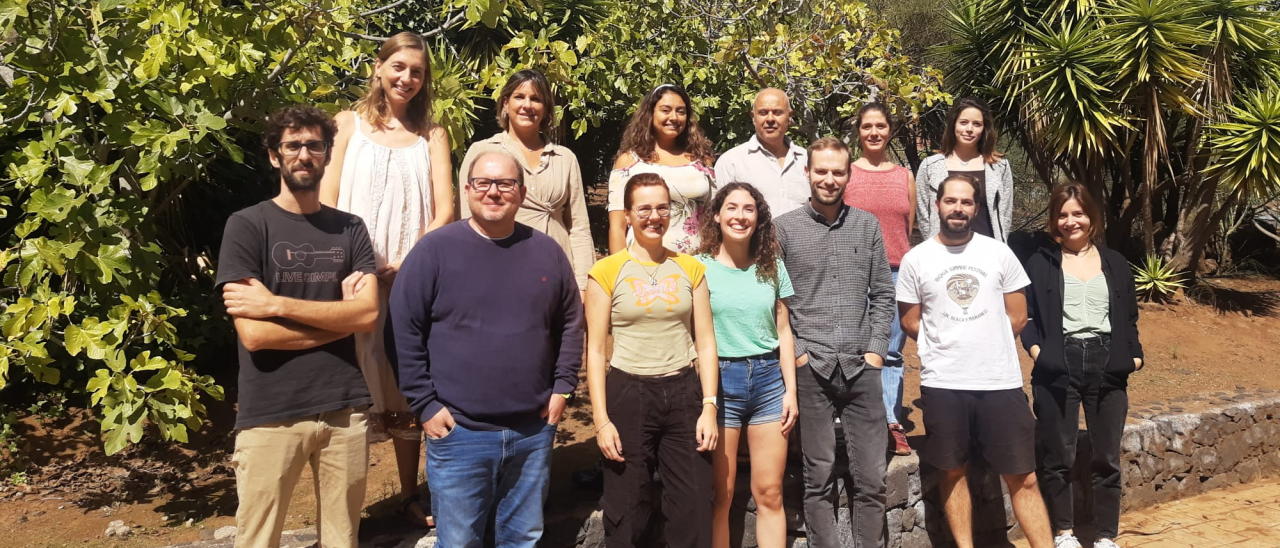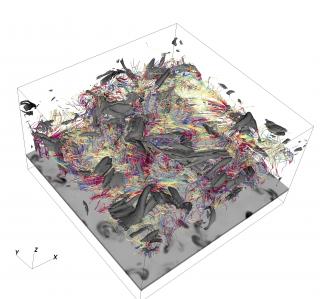Grants related:
General
Welcome to the Traces of Galaxy Formation research group website.
We are a large, diverse, and very active research group aiming to provide a comprehensive picture for the formation of galaxies in the Universe. Rooted in detailed stellar population analysis, we are constantly exploring and developing new tools and ideas to understand how galaxies came to be what we now observe.
A complex star formation history, as the one expected to describe galaxy evolution, needs a multidisciplinary approach to be fully understood. Our group at the IAC consists of experienced researchers in cosmological simulations, dynamical studies, stellar populations and morphological properties of galaxies up to high redshift. We combine different approaches (e.g. observations and theory, secular and cosmological evolution studies) to obtain a complete view of the dominant mechanisms driving the evolution of galaxies.
Within this general framework, we are currently exploring three main areas of research:
- Stellar population synthesis models
- Development of new stellar population synthesis models
- Stellar population analysis tools
- Universality of the stellar initial mass function (IMF)
- Cosmic evolution of galaxies
- Massive galaxy evolution
- Stellar populations in different environments
- Low surface brightness science
- Machine learning and cosmological simulations
- Evolutionary processes in nearby galaxies
- The role of black holes in the evolution of galaxies
- Surveys of nearby galaxies
- Stellar kinematics and dynamical models
If you want to get in contact or work with us, please send an email to the head of the group (Ignacio Martín-Navarro ignacio.martin [at] iac.es (ignacio[dot]martin[at]iac[dot]es)).
Members
Results
Here you can find some of our most recent highlights:
- Local variations of the stellar velocity ellipsoid - II. The effect of the bar in the inner regions of Auriga galaxies. Walo et al. 2022, MNRAS (https://ui.adsabs.harvard.edu/abs/2022MNRAS.513.4587W)
- Anisotropic satellite galaxy quenching modulated by black hole activity. Martín-Navarro et al. 2021, Nature (https://ui.adsabs.harvard.edu/abs/2021Natur.594..187M)
- Evaluating hydrodynamical simulations with green valley galaxies. Angthopo et al. 2021, MNRAS (https://ui.adsabs.harvard.edu/abs/2021MNRAS.502.3685A)
- Sub one per cent mass fractions of young stars in red massive galaxies. Salvador-Rusiñol et al. 2020, Nature Astronomy (https://ui.adsabs.harvard.edu/abs/2020NatAs...4..252S)
- Detection of young stellar populations in apparently quenched low-mass galaxies using red spectral line indices. de Lorenzo-Cáceres et al. 2020, MNRAS (https://ui.adsabs.harvard.edu/abs/2020MNRAS.498.1002D)
Scientific activity
Related publications
-
WEAVE-StePS: A stellar population survey using WEAVE at WHT
Context. The upcoming new generation of optical spectrographs on four-meter-class telescopes will provide valuable opportunities for forthcoming galaxy surveys through their huge multiplexing capabilities, excellent spectral resolution, and unprecedented wavelength coverage. Aims: WEAVE is a new wide-field spectroscopic facility mounted on the 4.2
Iovino, A. et al.Advertised on:
42023 -
CEERS Key Paper. II. A First Look at the Resolved Host Properties of AGN at 3 < z < 5 with JWST
We report on the host properties of five X-ray-luminous active galactic nuclei (AGN) identified at 3 < z < 5 in the first epoch of imaging from the Cosmic Evolution Early Release Science Survey. Each galaxy has been imaged with the JWST Near-Infrared Camera, which provides rest-frame optical morphologies at these redshifts. We also derive stellar
Kocevski, Dale D. et al.Advertised on:
32023 -
CEERS Key Paper. I. An Early Look into the First 500 Myr of Galaxy Formation with JWST
We present an investigation into the first 500 Myr of galaxy evolution from the Cosmic Evolution Early Release Science (CEERS) survey. CEERS, one of 13 JWST ERS programs, targets galaxy formation from z ~ 0.5 to >10 using several imaging and spectroscopic modes. We make use of the first epoch of CEERS NIRCam imaging, spanning 35.5 arcmin 2, to
Finkelstein, Steven L. et al.Advertised on:
32023 -
INSPIRE: INvestigating Stellar Population In RElics. III. Second data release (DR2): testing the systematics on the stellar velocity dispersion
Context. The project called INvestigating Stellar Population In RElics (INSPIRE) is based on VLT/X-shooter data from the homonymous on-going ESO Large Program. It targets 52 ultra-compact massive galaxies at 0.1 < z < 0.5 with the goal of constraining their kinematics and stellar population properties in great detail and of analysing their relic
D'Ago, G. et al.Advertised on:
42023 -
CEERS Key Paper. III. The Diversity of Galaxy Structure and Morphology at z = 3-9 with JWST
We present a comprehensive analysis of the evolution of the morphological and structural properties of a large sample of galaxies at z = 3-9 using early James Webb Space Telescope (JWST) CEERS NIRCam observations. Our sample consists of 850 galaxies at z > 3 detected in both Hubble Space Telescope (HST)/WFC3 and CEERS JWST/NIRCam images, enabling a
Kartaltepe, Jeyhan S. et al.Advertised on:
32023 -
Euclid preparation. XXV. The Euclid Morphology Challenge: Towards model-fitting photometry for billions of galaxies
The European Space Agency's Euclid mission will provide high-quality imaging for about 1.5 billion galaxies. A software pipeline to automatically process and analyse such a huge amount of data in real time is being developed by the Science Ground Segment of the Euclid Consortium; this pipeline will include a model-fitting algorithm, which will
Euclid Collaboration et al.Advertised on:
32023 -
INSPIRE: INvestigating Stellar Population In RElics - IV. The initial mass function slope in relics
In the last decade, growing evidence has emerged supporting a non-universal stellar initial mass function (IMF) in massive galaxies, with a larger number of dwarf stars with respect to the Milky Way (bottom-heavy IMF). However, a consensus about the mechanisms that cause IMF variations is yet to be reached. Recently, it has been suggested that
Martín-Navarro, Ignacio et al.Advertised on:
52023 -
The Physical Conditions of Emission-line Galaxies at Cosmic Dawn from JWST/NIRSpec Spectroscopy in the SMACS 0723 Early Release Observations
We present rest-frame optical emission-line flux ratio measurements for five z > 5 galaxies observed by the James Webb Space Telescope Near-Infared Spectrograph (NIRSpec) in the SMACS 0723 Early Release Observations. We add several quality-control and post-processing steps to the NIRSpec pipeline reduction products in order to ensure reliable
Trump, Jonathan R. et al.Advertised on:
32023 -
A new method for age-dating the formation of bars in disc galaxies. The TIMER view on NGC1433's old bar and the inside-out growth of its nuclear disc
The epoch in which galactic discs settle is a major benchmark for testing models of galaxy formation and evolution but remains largely unknown. Once discs settle and become sufficiently self-gravitating, stellar bars are able to form; therefore, determining the ages of bars can shed light on the epoch of disc settling, and on the onset of secular
de Sá-Freitas, Camila et al.Advertised on:
32023 -
First Look at z > 1 Bars in the Rest-frame Near-infrared with JWST Early CEERS Imaging
Stellar bars are key drivers of secular evolution in galaxies and can be effectively studied using rest-frame near-infrared (NIR) images, which trace the underlying stellar mass and are less impacted by dust and star formation than rest-frame UV or optical images. We leverage the power of JWST CEERS NIRCam images to present the first quantitative
Guo, Yuchen et al.Advertised on:
32023 -
The vertical structure of the spiral galaxy NGC 3501: first stages of the formation of a thin metal-rich disc
We trace the evolution of the edge-on spiral galaxy NGC 3501, making use of its stellar populations extracted from deep integral-field spectroscopy MUSE observations. We present stellar kinematic and population maps, as well as the star formation history, of the south-western half of the galaxy. The derived maps of the stellar line-of-sight
Sattler, Natascha et al.Advertised on:
42023 -
Exploring the stellar populations of backsplash galaxies
Backsplash galaxies are those that traverse and overshoot cluster cores as they fall into these structures. They are affected by environment, and should stand out in contrast to the infalling population. We target galaxies in the vicinity of clusters (R ≳ R 200) and select a sample in projected phase space (PPS), from the compilation of Sampaio et
Ferreras, I. et al.Advertised on:
12023 -
The origin of stars in the inner 500 parsecs in TNG50 galaxies
We investigate the origin of stars in the innermost 500 pc of galaxies spanning stellar masses of $5\times 10^{8-12}\, \mathrm{M}_{\odot }$ at z = 0 using the cosmological magnetohydrodynamical TNG50 simulation. Three different origins of stars comprise galactic centres: (1) in situ (born in the centre), (2) migrated (born elsewhere in the galaxy
Boecker, Alina et al.Advertised on:
32023 -
The Dawes Review 10: The impact of deep learning for the analysis of galaxy surveys
The amount and complexity of data delivered by modern galaxy surveys has been steadily increasing over the past years. New facilities will soon provide imaging and spectra of hundreds of millions of galaxies. Extracting coherent scientific information from these large and multi-modal data sets remains an open issue for the community and data-driven
Huertas-Company, M. et al.Advertised on:
12023 -
ERGO-ML I: inferring the assembly histories of IllustrisTNG galaxies from integral observable properties via invertible neural networks
A fundamental prediction of the ΛCDM cosmology is the hierarchical build-up of structure and therefore the successive merging of galaxies into more massive ones. As one can only observe galaxies at one specific time in the cosmic history, this merger history remains, in principle, unobservable. By using the TNG100 simulation of the IllustrisTNG
Eisert, Lukas et al.Advertised on:
22023 -
Keck spectroscopy of the coma cluster ultra-diffuse galaxy Y358: dynamical mass in a wider context
We examine ultra-diffuse galaxies (UDGs) and their relation to non-UDGs in mass-radius-luminosity space. We begin by publishing Keck/KCWI spectroscopy for the Coma cluster UDG Y358, for which we measure both a recessional velocity and velocity dispersion. Our recessional velocity confirms association with the Coma cluster and Y358's status as a UDG
Gannon, Jonah S. et al.Advertised on:
12023 -
Low-density star cluster formation: discovery of a young faint fuzzy on the outskirts of the low-mass spiral galaxy NGC 247
The classical globular clusters found in all galaxy types have half-light radii of r h ~ 2-4 pc, which have been tied to formation in the dense cores of giant molecular clouds. Some old star clusters have larger sizes, and it is unclear if these represent a fundamentally different mode of low-density star cluster formation. We report the discovery
Romanowsky, Aaron J. et al.Advertised on:
12023 -
Lessons learned from the two largest Galaxy morphological classification catalogues built by convolutional neural networks
We compare the two largest galaxy morphology catalogues, which separate early- and late-type galaxies at intermediate redshift. The two catalogues were built by applying supervised deep learning (convolutional neural networks, CNNs) to the Dark Energy Survey data down to a magnitude limit of ~21 mag. The methodologies used for the construction of
Cheng, T. -Y. et al.Advertised on:
12023 -
The dark side of galaxy stellar populations - II. The dependence of star-formation histories on halo mass and on the scatter of the main sequence
Nearby galaxies are the end result of their cosmological evolution, which is predicted to be influenced by the growth of their host dark matter haloes. This co-evolution potentially leaves signatures in present-day observed galaxy properties, which might be essential to further understand how the growth and properties of galaxies are connected to
Scholz-Díaz, Laura et al.Advertised on:
22023 -
A New Era of Intracluster Light Studies with JWST
Still largely unexplored, the diffuse light in clusters of galaxies traces the past and ongoing buildup of these massive structures. Here we present the first comprehensive study of the intracluster light (ICL) of the cluster SMACS J0723.3-7327 (z = 0.39) using the JWST Early Release Observations. These deep and high spatial resolution images allow
Montes, Mireia et al.Advertised on:
122022



